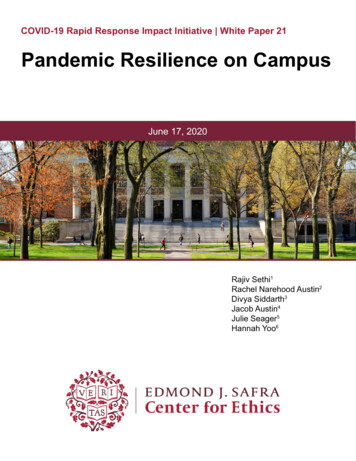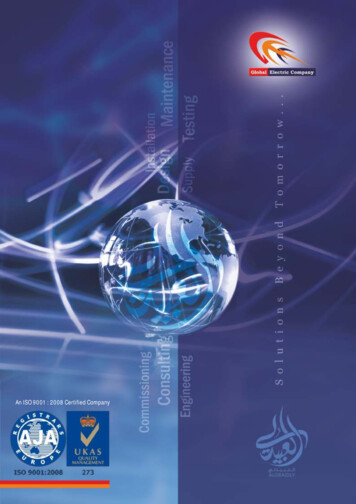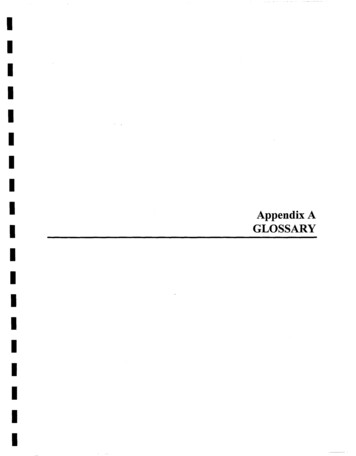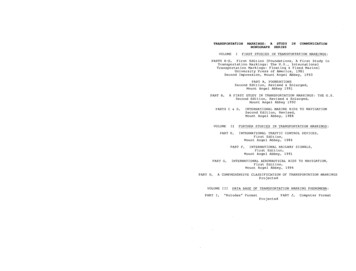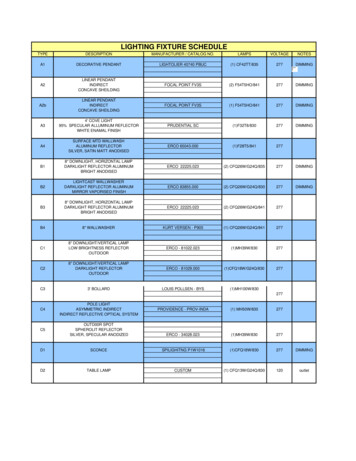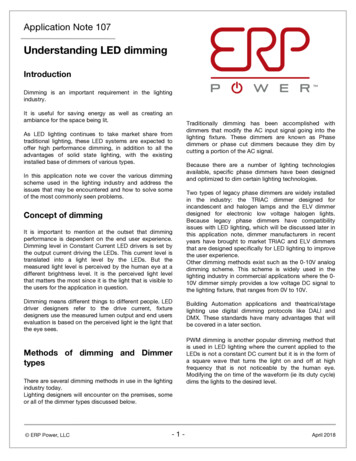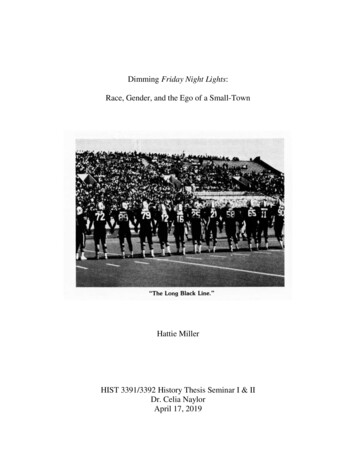
Transcription
Dimming Friday Night Lights:Race, Gender, and the Ego of a Small-TownHattie MillerHIST 3391/3392 History Thesis Seminar I & IIDr. Celia NaylorApril 17, 2019
i“When you hold hands, it means you’re not just 11 individuals, but 11 grouped as ONE, with onegoal in mind – to win the game. And when you reach over and grab a guy’s hand standing nextto you, it’s inspirational because you know he’s out there doing exactly the same thing you’redoing – trying to win the game.”– Dal WatsonPermian Football State Champion, 19841The cover photograph is from Regina Walker McCally, The Secret of Mojo, (Fort Worth, TX: R.W. McCally, 1986),214.1Regina Walker McCally, The Secret of Mojo, (Fort Worth, TX: R.W. McCally, 1986), 140.
ii
iiiAcknowledgementsTo Nate Hearne, Doak Huddleston, Michael Miller, Sr., Martha Mitchell, Liz Faught, and AlanJones for allowing me to record their stories and experiences.To Mike Adkins, for providing me with so many of my primary source documents.To Olivia Hartman, Anneliese Gallagher, and Madeline Sorg, for being the best thesiscollaborators and commiserators I could have ever wanted.To Amelia Marcantonio-Fields, for her guidance in crafting my lovely maps.To everyone who read a draft of my thesis prior to submission: Anneliese Gallagher, John SikesJohnson, Tassy Miller, Celia Naylor, Carson Smith, and Mickey Warshaw.To Olivia Hartman especially, for walking every terrifying step of the history thesis process withme and being a constant sounding board for ideas and anxieties related to theses and other lifedramas.To John Sikes Johnson, for our weekly therapy sessions and for validating my rage towards thelibrary hours set by Barnard College in the fall of 2018.To my father, Todd Vesely, for answering my endless questions about the specific details ofPermian High School and connecting me with so many different sources for my research.To my mother, Tassy Miller, for sending me nightly videos of my puppy, Millie, at the precisetime each evening that I was completely panicking about this thesis, for reading each chapter toomany times to count, and for funding thesis snack purchases for all of the thesis gang.And most of all to Celia Naylor, for being the most understanding and nurturing thesis advisor inthe world. I am eternally thankful for all that you did in getting me to this point.
iv
vTable of ContentsINTRODUCTION . 1CHAPTER 1: “FEAST OR FAMINE”. 8The Culture of Odessa, TexasCHAPTER 2: “A FORM OF EDUCATIONAL MALPRACTICE” . 23The Fight to Desegregate Odessa, TexasCHAPTER 3: “WHERE’S THAT BOOK WRITER DUDE?”. 37The Process and Impact of Publishing Friday Night LightsCONCLUSION . 50APPENDIX A . 53A map of the 254 counties in Texas with Ector and Midland counties highlightedAPPENDIX B . 54The 1980 racial makeup of Ector County with an overlay of the high school boundariesprior to desegregationAPPENDIX C . 55The 1990 racial makeup of Ector County with an overlay of the high school boundariesfollowing desegregationBIBLIOGRAPHY . 56
vi
1Introduction“This must not be planet earth this must be hell.”But it wasn’t. It was just Odessa.2The twenty-minute drive from my hometown of Midland, Texas to the neighboring townof Odessa,3 where my parents spent most of their careers, is one that I have taken more timesthan I can count. Midland is situated just northeast of Odessa with a drive of less than twentyfive miles between the two no matter which highway you take. The towns are commonly referredto as a metropolitan area with estimates of a combined population of approximately 325,000.4 Asan elementary school student, I would fall asleep to the sounds of Golden Oldies on 97.9 FM asmy mom drove in the early hours of the morning to make it to morning practice with the juniorhigh gymnastics program at Permian High School, where my parents coached the women’s andmen’s teams. Sleeping was the better option compared to watching the scenery go by as therolling, flat plains of West Texas are fairly ordinary. The Midland-Odessa area is halfwaybetween El Paso, Texas in the westernmost corner of the state and the Dallas-Fort Worth area,which is located in north-central Texas. There is no greenery like that of the state’s easternregion, nor is there the rich, red dirt plateaus of the Big Bend region that are reminiscent of theOld West. The wide-open spaces to either side of Highway 191 are littered with pumpjacks,pumping in search of the lifeblood of the region that keeps so many businesses and familiesafloat and even thriving. When my mom and I took this route to school through 2005, pumpjacksand the occasional cow were the only points of interest between Midland and Odessa, but over2H.G. Bissinger, Friday Night Lights: A Town, a Team, and a Dream (Boston: Da Capo Press, 2000), 30.The location of Midland and Ector Counties, where the cities of Midland and Odessa respectively are located, isfeatured in Appendix A.4Trevor Hawes, "Midland-Odessa CSA Leads the Nation in Population Growth," Midland Reporter-Telegram,March 29, 2016, accessed April 7, php.3
2the years, more and more businesses have been established along the highway, signifying thechanging times and profitability of the oil industry.You arrive at Odessa via an overpass which offers you a birds-eye view of the town. Youmerge from Highway 191 onto 42nd Street and to the left you see the University of Texas of thePermian Basin, the only four-year university between the sister cities offering bachelor’s andmaster’s programs, which inexplicably features a nearly full-size replica of Stonehenge. To yourright you pass the Walmart, the Target, the HEB (the world’s greatest grocery store chainavailable only in Texas and parts of Mexico), the only Chick-Fil-A in town, and the mall, whichboasts a movie theatre, ice skating rink, indoor carousel, and headquarters for the local CBS 7news team. Driving further down the road, you pass Memorial Park on the left, which erects aflag in honor of every life lost on September 11th each fall5 and where my parents used to spendtheir lunch breaks when they were still just dating. A few more blocks down the road, you take aleft and finally arrive at Permian High School.My mother graduated from Odessa High School, the westside feeder school, andwhenever she and her brother drove past Permian High while growing up my grandmother wouldurge them to hold their breath, so as not to breathe in that Permian air, something my mom couldnever manage as a little girl. It was perhaps one of my grandparents’ greatest disappointmentswhen my mom accepted a job at Permian High School teaching special education and coachinggirls’ gymnastics, something they silently and not-so-secretly begrudge to this day. Even thoughI graduated from Midland High School, I often joke that I have more of an emotional connectionto Permian than to my own alma mater given how many hours of my childhood were spent in thegym during weekday practices, in the press box at Ratliff Stadium during Friday night games5Odessa Parks and Recreation, "An American Tribute," September 6, 2018, accessed April 7, /special-events/american-tribute.
3with my dad, and traveling with the gymnastics team on the weekends. There is an energy withinPermian that is distinctly different from other high schools, something that I was acutely awareof even as a child and believe even more strongly after attending a different high school andfeeling its absence.Few high schools can boast multiple books, a movie, and a TV show dedicated to thesuccess and mystique of their football program. Friday Night Lights, by H.G. “Buzz” Bissinger,was published in 1990 after the author spent a year following the Permian Panthers’ 1988football season. Bissinger arrived at Permian High assuring the administration that he wanted towrite a book that celebrated the magic of Permian football, the winningest team of the ModernDay era of high school football.6 What resulted from Bissinger’s time, however, left a stain onOdessa and on Permian High School for years to come. The book spares no detail when it comesto the racial animosity of Odessa residents, dedicating numerous pages to the townspeople’sfrequent use of the n-word with apparent abandon.7 He also situates senior James “Boobie”Miles, first-string fullback for the Panthers, as his tragic hero, utilizing him as another exampleof the town’s racism. Bissinger argues that Boobie was taken advantage of because of his athleticskills like so many other Black players on the team and that Boobie’s tragic downfall was thedirect result of his participation in Permian football.However, Bissinger fails to capture the events that preceded the ’88 football season andproperly contextualize the racial attitudes of the town. The events of Friday Night Lights takeplace only five years after Ector County Independent School District (ECISD) first desegregatedafter a drawn-out court battle, that took over a decade to resolve with the United Statesgovernment, a crucial detail necessary to unpack fully before casting judgement on the town.67McCally, The Secret of Mojo, 19.Bissinger, Friday Night Lights, 34.
4There is plenty that can and should be said about the town’s dark history of handling race;however, Bissinger does a disservice to the people of Odessa and, most importantly, the studentsof Permian High School in highlighting the unsavory elements of their culture without allowingspace for the positive aspects of Permian and West Texas.There is arguably no greater pinnacle of American masculinity than American footballand West Texas embodies this idea to its fullest. Author and West Texas resident Regina WalkerMcCally writes in her work The Secret of Mojo, that “no other sport fits our nation’s rough-andtumble past better than football.”8 During the decades prior to desegregation, Permian football,like so many other high school football programs across the country, was not just a celebration ofAmerican masculinity, but of white masculinity given the town’s continued segregation. Thespirit of Mojo, that mysterious moniker adopted by the team in the late 1960s as an undefinableencapsulation of Permian pride, crossed generational divides. It “[fostered] an intimacy betweenfathers and sons that they’d probably be uncomfortable with in other situations, and the uniquely‘Mojoian’ dream of going to state became a dream that many players fulfilled for their dads.”9The winning tradition of Permian football, built over decades and sustained through culturalnorms, was a source of pride for many in the town.Cultural shifts in Odessa in the 1980s, such as the desegregation order of 1982,threatened the status quo of the town in a number of ways, not the least of which was high schoolfootball. Additionally, the town was experiencing a period of financial strife following a one ofimmense wealth due to the fallen price of oil, which dictates the nature of the economy for theentirety of the town. The events that propelled desegregation on top of a struggling economy89McCally, The Secret of Mojo, 11-12.Ibid, 164.
5meant that the people of Odessa felt themselves being thrust about in a changing world with noclear idea of what their new role would be.Enter Buzz Bissinger.Bissinger, a Pulitzer-prize winning author and native New Yorker,10 came to Odessa withhis family in 1988 with a mission to write a book that he proclaimed would be the Hoosiers offootball.11 It was an idea he had had for decades, and he was told by experts in the field ofathletics that there was only one place in the country with a football program like the one he waslooking for: the Permian Panthers of Odessa, Texas.12 Though many were wary of Bissinger’sintentions from the start, far more were thrilled that someone finally wanted to share the magicof Mojo with the world. Bissinger could not have arrived at a better time to stoke the egos ofPermian fans. It was during points of stress that the town banded together even more stronglyaround the things that united them, like the success of their football team. At its height, thePermian Panthers were a consistent source of pride in a town that had so few other aspects thatmade them special. However, what Bissinger pitched and what he published could not have beenmore different.Instead of exalting the triumphs of the Permian Panthers like so many had expected,Bissinger’s book shone a light into all the darkest corners of the town and of their footballprogram. They were described as racist backwoods hicks who cared only about high schoolfootball, something that the rest of the world already believed about them. The book wassuccessful in part because it confirmed the biases many in the country held towards WestBuzz Bissinger, “About Buzz,” accessed April 7, 2019, https://www.buzzbissinger.com/bio/.The 1986 film Hoosiers was a loose retelling of the 1954 Indiana high school basketball team that, as the filmportrays it, overcame the odds to win the state championships, when in actuality their team had a long-establishedbasketball program and was considered a favorite to win. See Roger Elbert, “Hoosiers,” Elbert Digital, LLC,accessed April 7, 2018, 2Bissinger, Friday Night Lights, xi.1011
6Texans. This special gem that Odessa had once been so proud of was now portrayed for all theworld to see as this dark and twisted element without acknowledging the countless ways thathigh school football was an incredible force for community building in West Texas. Bissingerdid not acknowledge all the ways that Permian football was a lifeline for so many students and away to receive the mentorship and guidance that they so desperately needed in their lives.I grew up knowing all too well the pain Friday Night Lights inflicted on the town ofOdessa and on the high school I loved so much. I avoided the book and all its later iterations forso many years because I thought that I knew the story already. In returning to my hometown andto Permian High School for one of the first times since I was in elementary school this past year,I learned the story was far more complex and certainly more nuanced than is portrayed byBissinger. The pain inflicted by Friday Night Lights is a complicated one, and it is a blow fromwhich the town has never fully recovered. Permian football, no matter how much its status mayhave waned in the decades since Bissinger left his mark, is still the single most unifying force inthe city of Odessa. By examining this program and the broader aspects of Odessa in the 1980sone can understand what Bissinger got wrong and even what he got right.In my first chapter, “Feast or Famine,” I explain the culture of Odessa, Texas byexamining two key facets: the oil-based economy and the rise of Permian football. Thoughseemingly unrelated, the consistency of the Panthers’ success compensated for the insecuritiesbrought on by the town’s boom and bust economy. I highlight the positive effects Permianfootball has on Odessa, an element of analysis that is fundamentally lacking in Bissinger’s work.In my second chapter, “A Form of Educational Malpractice,” I outline the battle fordesegregation in Odessa, pulling from the experiences of both educators and students from thistime in addition to related newspaper articles archived by ECISD. Odessa’s abnormal timeline
7for desegregating is imperative in framing the racial attitudes of the town in the 1980s, and theintersection of race and sports is crucial both to my analysis and to Bissinger’s. My third andfinal chapter, “Where’s That Book Writer Dude?” describes how Bissinger became a part of thePermian family, the impressions he left on those he encountered, and the lasting impact ofFriday Night Lights. Given that his work tells the stories of real people, giving Odessans achance to voice their feelings of betrayal after Bissinger profited off their story is critical to mygoals in writing this thesis.I am proud to call West Texas my home. I am proud of the things that make West Texanstough, resilient, and enable them to fight for what they believe. However, my own beliefs areoften at odds with those that some West Texans extoll, some of which Bissinger so astutelypinpoints. However, I depart from Bissinger in that I spent nearly two decades as opposed to asingle year immersed in the culture of West Texas. I am intimately aware of the image my regioncan often project, but more importantly, I believe that West Texas can do better. I also believethat it is disingenuous and ineffective to shine a light on the problematic parts of a region’sculture alone, particularly when it is that culture’s positive attributes that can provide a pathwayto change. In writing this thesis, I hope to give the nuances of Permian football the care theydeserve without sacrificing an honest reflection on how the town can move forward.
8Chapter 1: “Feast or Famine”The Culture of Odessa, Texas“There are so few other things we can look at with pride Whensomebody talks about West Texas, they talk about football. There isnothing to replace it. It’s an integral part of what made thecommunity strong. You take it away and it’s almost like you stripthe identity of the people.” – Brad Allen, President of the PermianFootball Booster Club in the 1980s13Within popular culture, there is an image frequently conjured of the single-industry town;the coal mine, the factory, something that employs all the men of the town while establishing andreinforcing a clear social hierarchy. Should anything happen to alter this way of life, everyone isaffected, from the lowliest worker to those few individuals who hold the purse strings. In filmslike Billy Elliot (2000), All the Right Moves (1983), Rudy (1993), October Sky (1999),Flashdance (1983), and more, these energy producing plants, quite literally, give life to the town.In West Texas, the people do not feed off the mines, but from a different source of energy burieddeep in the ground.The Permian Basin, a large swath of land “approximately 250 miles wide and 300 mileslong, across West Texas and southeastern New Mexico” in the western-most region of the stateof Texas, is the largest shale formation in the state and one of the most important oil and naturalgas producing regions in the country. 14 Today, the region can produce over three million barrels13Bissinger, Friday Night Lights, 43.Chevron Corporation, “The Permian Basin: Business Overview: American Energy Powerhouse,” accessed April7, 2019, https://www.chevron.com/projects/permian.14
9of oil a day,15 accounting for 68% of the state’s total production and 80% of its oil reserves.16 Inaddition to oil, the Permian Basin produces “nearly 4 billion cubic feet of natural gas eachday.”17 It employs thousands in towns like Midland and Odessa. The very existence of theindustry fuels the success of other trades that are not directly related but nonetheless dependenton the business of those who come to the Basin in search of their fortunes. Many who study theregion have even estimated that the amount of petroleum still sitting beneath the earth couldtransform the Permian Basin into the largest oil producing region in the world, transformingTexas into the United States’ greatest hope for the future of fossil fuels.18Given the importance of the Permian Basin as a producer of petroleum and natural gas,Odessa is dramatically affected by the industry’s boom and bust cycle. It is an ever-enduringsequence where each boom leaves the town convinced that this one will last, with thousands ofnew residents pouring into the city to seek their fortunes. In 1970, Odessa had only 90,000residents.19 At that time, “blue-collar Odessa was among Texas’ proudest boom towns. Situatedin the heart of one of the country’s richest oil-producing regions, it was a raw and vital place,dominated by hulking refineries, manufacturing plants, and clangorous shipping yards.”20 Oncethe price of oil began skyrocketing, the population shot up to 120,000,21 a number which doesn’teven take into consideration the number of residents in the neighboring Midland which is just as15Robert Rapier, "Why The Permian Basin May Become The World's Most Productive Oil Field," Forbes,December 27, 2018 accessed March 7, 2018, uctive-oil-field/#2706080f5ccb.16UTPB Center for Energy and Economic Diversification, "Permian Basin Statistics," The University of Texas ofthe Permian Basin, accessed November 21, 2018, Michael E. Webber, "Fracked," The Alcalde, accessed November 20, ml.19People Staff, "A Dream Dies in Texas," PEOPLE.com, November 10, 1986, accessed November 20, xas-vol-26-no-19/.20Ibid.21Ibid.
10integrally connected to the boom and bust cycle, before declining just as quickly with the nextbust.Image 1: Map of shale formations within the state of Texas.22Since the 1920s, Odessa has been “enmeshed in the cycles of the boom-and-bust oiltown.”23 In 1988, Odessa was recovering from two back to back busts in oil prices, 1983 and1986. Between the end of 1982 and the beginning of 1983, the cost of oil dropped from 92.03per barrel to 74.78 in just over six months.24 The decrease in prices in 1983 resulted from acombination of factors including “continued warm weather in the Northeast [which] postponedthe need for heating oil purchases” in addition to relatively high oil inventories “from the stockbuildup earlier [in 1983] amid fears of supply disruptions from the Iran-Iraq war.”25 The cost of22Webber, "Fracked."Bissinger, Friday Night Lights, 29.24Macrotrends, Average monthly West Texas Intermediate (WTI) crude oil price from January 1960 to August 2018(in U.S. dollars per barrel), accessed October 16, 2018, istorychart.25The New York Times, "Oil Prices Are Sharply Lower," The New York Times Archives, November 26, 1984,accessed November 20, 2019, ices-are-sharply-lower.html.23
11oil is far more complicated than simply assessing what is being produced in West Texas; it isinfluenced by the environment in addition to the geopolitical context that is so often wrapped upin the international oil and gas industry. The cost of oil per barrel continued to generally decreaseover the next few years before yet another dramatic bust. Between October of 1985 and March of1986, the price per barrel dropped from 70.66 to 24.22.26My grandfather, Michael Miller, Sr., worked in the oil industry during the summers fromthe time he was fifteen until he dropped out of high school at sixteen to work full-time beginningas a roustabout.27 A roustabout is an entry-level position requiring few skills or training andentails tasks such as cleaning “equipment, including drills and pumps and machinery and[keeping] work areas clean and orderly.”28 He worked his way up before becoming an operationssuperintendent; he retired at the age of 67. With over fifty years of experience in oil and gas, mygrandfather attributes his success in the industry, despite the many booms and busts over thedecades that sent so many others scattering, to the fact that he started from the bottom andworked his way up, making him an invaluable resource to the companies for whom he worked.From his experiences, those who were responsible for the groundwork immediatelypertaining to the maintenance of the oil rigs were largely safe during busts as companymanagement still needed people to monitor the oil rigs, regardless of the cost of oil; those inpositions adjacent to the oil field, such as construction and consulting workers who weretypically men in middle-class families, were hit the hardest.29 As hundreds of these families lefttown, enrollment rates across Midland and Ector County Independent School Districts (MISD &26Macrotrends, Average monthly West Texas Intermediate (WTI) crude oil price.Michael Miller, Sr, "Interview with Michael Miller, Sr. on Oil Industry in Odessa in the '80s," telephone interviewby author, November 19, 2018.28Ron White, "What Does a Roustabout Do in the Oilfields?" Chron.com, November 09, 2016, accessed November22, 2018.29Miller, "Interview with Michael Miller, Sr."27
12ECISD) fell drastically.30 However, this same group was also able to move out of West Texasmost easily because of their socioeconomic advantage; as a result, many of these families movedout of Odessa to pursue more lucrative work in larger, more affluent metropolitan areas likeHouston.31The exodus of the families who ran larger companies that existed to support the oilindustry resulted in the loss of jobs for many of the lower-income individuals who relied on thesecompanies for work. This created a trickle-down effect that is so integral to the boom and bustcycle of West Texas. Whenever the price of oil crashes, it is not just those in the fields who areaffected; the whole town feels the crushing blow from this drop in revenue. By November of1986, Odessa’s unemployment rate “reached 17.3 percent, the second highest in the state,”32while motel after motel shuttered its doors and more than 400 establishments filed forbankruptcy that year.33 Just as every boom brings prosperity for restaurants, retail stores, andother establishments, each bust decimates these businesses just as quickly.34 Across the state, atleast twenty banks closed in 1986 alone,35 and a quick drive around Midland or Odessa duringthis time would reveal abandoned house after house along with countless boats and RV’s for sale– remnants of a bygone era in which families could afford the luxury of a lake vacation milesaway from the desert sun of West Texas.36There is no doubt that everyone in the town was hurt by the drop in oil prices, but thedamage took on a different face for each socioeconomic class. Those responsible for themanagement of oil and gas companies were largely safe, though forced to contend with far fewer30Ibid.Ibid.32People Staff, "A Dream Dies in Texas."33Ibid.34Webber, "Fracked."35People Staff, "A Dream Dies in Texas."36Miller, "Interview with Michael Miller, Sr."31
13luxuries than they were accustomed, while those within the lowest socioeconomic level weremost dramatically hit. “Because I had started out in the oil patches as a roustabout at the verybottom of the ladder, and worked up, I could do multiple things so I was safe,”37 my grandfatherrecounts, reflecting on the oil busts of the 1980’s. Whenever a bust would hit the oil industry, atypical pattern would emerge dictating who would keep their job, like my grandfather, and whowas most at risk:When a bust starts the person closest to the wellhead, that means the personworking in the field, is usually the safest. The upper management goes first,especially engineering, geology, because they’re shutting down the drillingrigs so the small guys, pumpers those folks, they didn’t get hurt. Now theconstruction guys, the roustabout companies, the contract people they got hurtreally bad. Those people were starving to death because they didn’t have anywork.38The image of the once thriving, now poverty-stricken roustabout became a familiar sight inOdessa during this time. One report of the bust of ’86 describes one Odessa man ElbertShellenberger and his sister Irene who were forced to find enough money to provide forthemselves by whatever means necessary:[The Shellenbergers] are looking for aluminum cans, which they will salvage andsell for 23 a pound. A craggy-faced, leather-skinned roughneck who worked thederricks, Elbert has been out of work more than two years. “You never think thiskind of thing could happen to you,” he says, sadly, reaching into a barrel.39At the same time that lower-income workers like roustabouts and construction workerswere losing their jobs, the middle- and upper-class owners and managers of these companieswere also hit with changing social dynamics resulting from the economic turmoil. Across thestate, Texas billionaires quickly became millionaires40 as hundreds of single-income familiesfound themselves renegotiating their family dynamic. My grandfather remembers that he worked37Ibid.Ibid.39People Staff, "A Dream Dies in Texas."40Ibid.38
14with several men who were the primary breadwinners for their families, bringing home a reliableand considerable income when suddenly everything shifted. “[One guy I worked with] and hiswife found lesser jobs making close to the same money and they never came back to the oilfield they got burned in the oil patch and a bunch of those men didn’t come back.”41 Formany families, like the one my grandfather describes, the true loss from the bust was not definedsolely by their income, but
2 H.G. Bissinger, Friday Night Lights: A Town, a Team, and a Dream (Boston: Da Capo Press, 2000), 30. 3 The location of Midland and Ector Counties, where the cities of Midland and Odessa respectively are located, is featured in Appendix A. 4 Trevor Hawes, "Midland-Odessa CSA Leads the

